

Must-Have Apps for the Outdoor Photographer - Part 1: Planning. Back in the dark days without Internet, tablet and apps, planning a landscape photo shoot meant a lot of work.
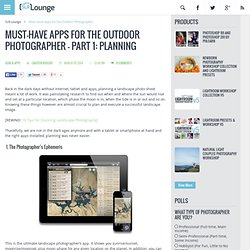
It was painstaking research to find out when and where the sun would rise and set at a particular location, which phase the moon is in, when the tide is in or out and so on. Knowing these things however are almost crucial to plan and execute a successful landscape image. [REWIND: 10 Tips for Stunning Landscape Photography] Photography Uncovered - Helping You Make Better Photos. ULTIMATE DIY Follow Focus. DIY Modified Hypergonar HiFi2 Anamorphic Adapter. Sensor types - Learn - Snapsort. Short Description Image Sensor Photo of a Canon CMOS sensor The sensor type refers to the semiconductor design/arrangement of the image sensor.
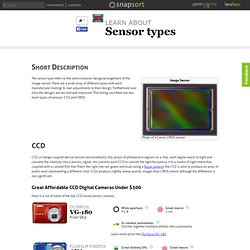
There are a wide array of different types with each manufacturer making its own adjustments to their design. Furthermore over time the designs are revised and improved. CCD or charge coupled device sensors are essentially tiny arrays of photoactive regions on a chip, each region reacts to light and converts the intensity into a electric signal- this permits each CCD to convert the light focused on it to a matrix of light intensities, coupled with a colored film that filters the light into red, green and blue (using a Bayer pattern) the CCD is able to produce an array of pixels each representing a different color.
Great Affordable CCD Digital Cameras Under $500 Here is a list of some of the top CCD based sensor cameras. Top CMOS Camera. The Best DIY Beauty Dish. Shoot the Supermoon Like an Astrophotographer. By: Luis Argerich June and July 2013 full Moons are featured as “supermoons.”
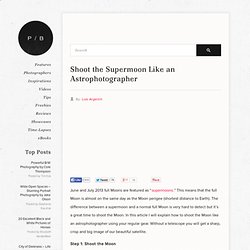
This means that the full Moon is almost on the same day as the Moon perigee (shortest distance to Earth). The difference between a supermoon and a normal full Moon is very hard to detect but it’s a great time to shoot the Moon. In this article I will explain how to shoot the Moon like an astrophotographer using your regular gear. Without a telescope you will get a sharp, crisp and big image of our beautiful satellite. Step 1: Shoot the Moon Use your longest lens (200mm, 300mm, 400mm) and shoot the Moon from a good tripod. I’ve written a previous article with tips to shoot the Moon and you can read it before proceeding to the next step. Step 2: Process your RAW files After shooting you need to process the RAW files and convert them to 8 bit Tiffs (no need for 16 bits). Each of your 8-bit tiff files should look like this: Not a big winner uh? 1. 2. 3. 4. 5. 6. 7. 7. And here’s the final result: HDR Tutorial Part 3 – High Dynamic Range Photography.
HDR Tutorial Part 3 Navigating the HDR Tutorial You made it to page 3 of the Choose Your Own Adventure!
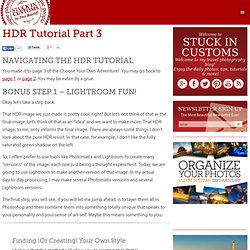
You may go back to page 1 or page 2. You may be eaten by a grue. Bonus Step 1 – Lightroom Fun! Okay let’s take a step back. That HDR image we just made is pretty cool, right? So, I often prefer to use tools like Photomatix and Lightroom to create many “versions” of the image, each one just being a thought experiment. The final step, you will see, if you will let me jump ahead, is to layer them all in Photoshop and then combine them into something totally unique that speaks to your personality and your sense of art-self.
Finding (or creating) your own styleI believe that this method will allow you to create a style that is quintessentially your own! Okay let’s get into Lightroom here. I have tweaked the sliders on the right to do many of the things that HDR does. After I create this image, I export it into a temporary directory. So, let’s get back to the notion of “ideas.” How to Shoot the Night Sky (Introduction to Astrophotography) The following post on photographing the night sky is by jgomez65 – one of dPS’s forum members.
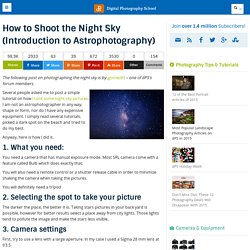
Several people asked me to post a simple tutorial on how I took some night sky pictures. I am not an astrophotographer in any way, shape or form, nor do I have any expensive equipment. I simply read several tutorials, picked a dark spot on the beach and tried to do my best. Anyway, here is how I did it. DSLR Lenses.